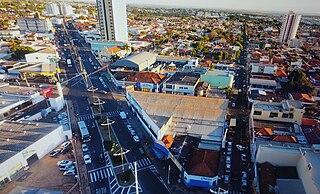
Barretos is a municipality in the northern part of the state of São Paulo, Brazil. The city has approximately 122,833 inhabitants (IBGE/2020) and an area of 1566.1 km2. Barretos belongs to the Mesoregion of Ribeirão Preto.

Araras is a municipality located in the interior of State of São Paulo, Brazil. The population is 135,506 as of the 2020 IBGE estimate.

Barueri is a Brazilian municipality in the State of São Paulo located in the northwestern part of the Metropolitan Region of São Paulo. The population is 276,982 in an area of 65.70 km2 (25.37 sq mi).

Artur Nogueira is a city in the state of São Paulo in Brazil. It is part of the Metropolitan Region of Campinas. The population is 55,340 in an area of 178.03 km2. The elevation is 595 m.

Bady Bassitt is a municipality in the state of São Paulo, Brazil. The population is 27,260 in an area of 110 km². The town is located 7 km from São José do Rio Preto, and the municipality belongs to the Microregion of São José do Rio Preto.

São Pedro is a municipality in the state of São Paulo in Brazil. The population is of 35,980 (2020) in an area of 611.278 km2 (236.02 sq mi).

Fernandópolis is a municipality in the state of São Paulo, Brazil. The population is 71,186 in an area of 550 km2. Fernandópolis is the center of the microregion of Fernandópolis with 104,623 inhabitants and area of 2,811.7 km2.

Holambra is a municipality in the state of São Paulo in Brazil. It is part of the Metropolitan Region of Campinas. Holambra is the largest producer of flowers and ornamental plants in Latin America, also hosting the largest spring event in the continent, the Expoflora. The population is 15,272 in an area of 65.58 km2. The elevation is 600m on average.

Iacri is a municipality in the state of São Paulo in Brazil. The population is 6,295 in an area of 322 km². The elevation is 499 m.

Jales is a municipality in the state of São Paulo, Brazil. The population in 2020, according to the IBGE, is 49,201 inhabitants. The city is located 601 km from the city of São Paulo.

Lucélia is a municipality in the state of São Paulo in Brazil. The population is 21,886 in an area of 315 km². The elevation is 438 m.

Mirassol is a municipality in the state of São Paulo, Brazil. The city is located in the northern part of the state, 453 km from the city of São Paulo and 15 km from São José do Rio Preto. Mirassol has 60,303 inhabitants (IBGE/2020).

Nhandeara is a municipality in the state of São Paulo, Brazil. The city has a population of 11,527 inhabitants and an area of 435.8 km².

Nova Odessa is a Brazilian municipality in the state of São Paulo. It is part of the Metropolitan Region of Campinas. The population is 60,956 in an area of 73.79 km2. Nova Odessa was founded on May 24, 1905, by Carlos José de Arruda Botelho, Secretary of Agriculture of the state of São Paulo, and then settled by Ukrainians and Latvians.

Paraguaçu Paulista is a municipality in south-west of the state of São Paulo in Brazil. It is part of the Microregion of Assis, situated in the middle Paranapanema Valley. The population is 45,945 in an area of 1001.3 km2. It's the second largest population of microregion and the 3rd of mesoregion, and is 422 km away from the capital, São Paulo.

Pereira Barreto is a municipality in the state of São Paulo in Brazil. The population is 25,677 in an area of 974 km². The elevation is 347 meters.

Pompeia is a municipality in the state of São Paulo in Brazil. The population is 22,172 (2020) within an area of 784 km2. In 2000, its Human Development Index was 0.816.

Paraitinga River

Tanabi is a municipality in the northwestern part of the state of São Paulo, Brazil. The population is 26,101 inhabitants (IBGE/2020). The city is located 447 km from the city of São Paulo and 30 km from São José do Rio Preto. Tanabi was founded on July 4, 1882.

Álvares Florence is a municipality in the state of São Paulo, Brazil. It has a population of 3,647 inhabitants (IBGE/2020) and an area of 362.9 km2.
























